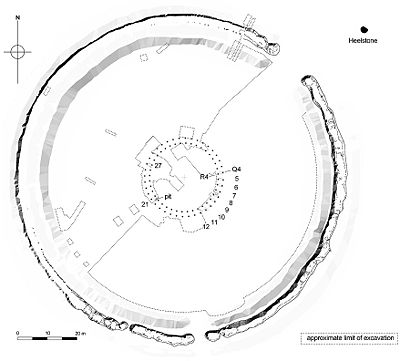
Q and R Holes
Encyclopedia

Stonehenge
Stonehenge is a prehistoric monument located in the English county of Wiltshire, about west of Amesbury and north of Salisbury. One of the most famous sites in the world, Stonehenge is composed of a circular setting of large standing stones set within earthworks...
.
Beneath the turf, and just inside the later Sarsen Circle are a double arc of buried stoneholes, the only surviving evidence of the first stone structure (possibly a double stone circle) erected within the centre of Stonehenge (Figs.1 & 2) and currently regarded as instigating the period known as Stonehenge Phase 3i This phase tentatively began as early as 2600 BC, although recent radiocarbon dates from samples retrieved from one of the sockets in 2008 during excavations by Darvill and Wainwright suggest a date of around 2400 to 2300 BC. The final report is yet to be published, but some interesting results follow from the partial excavation of Q Hole 13 where 'associations with Beaker pottery' where noted . Although first encountered by William Hawley
William Hawley
Lieutenant-Colonel William Hawley was a British archaeologist who most famously undertook pioneering excavations at Stonehenge....
in the 1920s it was Richard Atkinson who formally identified and named these irregular settings in 1954: ‘In choosing this designation, I had in mind John Aubrey’s frequent use, as a marginal note…of the phrase ‘quaere quot’ – ‘inquire how many’ – which seemed appropriate to the occasion.’ Their place at the beginning of the stone monument phase has been recognized from their stratigraphic relationships: in places they were cut through by both the settings of the later and still partly surviving Bluestone Circle and also by a stonehole dug for one of the uprights of the Sarsen Circle.
Description
The diameter of the outer (Q) circuit is c. 26.2 m and that of the inner (R) is, 22.5 m; with an average spacing between the paired stone settings of 1.5 m. These trench-like intrusions are roughly 2 m long and 1 m wide, set radially and slightly enlarged at each end to provide paired stone sockets to a depth of around 0.6 m, the intervening strip generally re-filled with chalk rubble.

